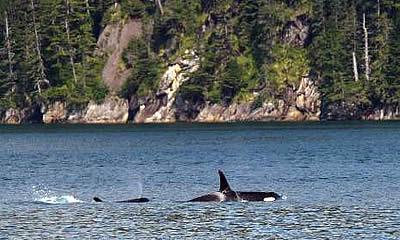 |
Alaska whale watching tours allow the visitors an opportunity to observe and photograph Humpback, Orca, Gray, and Beluga whales, along with many other marine mammals, in their natural environment. |
 |
 |
Contact Us At: |
 |
|
 |
|
Seward Alaska Whale Watching.Whales in Seward AK.; Wow, Seward Alaska Whale Watching Tours are a must for everyone in 2011. Visitors to Alaska all agree that booking a sightseeing cruise from scenic Seward into the Kenai Fjords National Park is the best place to see what coastal Alaska is all about! See the Whales of Seward Alaska including Humpback Whales, Gray Whales, Killer Whales, Blue Whales and possibility the Bottle Nose or Minke whale. Visitors to Alaska all agree that booking a sightseeing cruise from scenic Seward into the Kenai Fjords National Park is the best place to see what coastal Alaska is all about!
Seward Whale Watching Tours.The two most commonly seen whales in the park near Seward Alaska are
the Orcas (Killer Whale) and the Humpback. The Humpback Whales in Seward Alaska.The Humpback whale is a giant weighing in at up to 40 tons. They feed on Plankton and krill, eating as much as one tone per day. Humpbacks are best viewed during the months of May through September with the peak viewing time from the middle of June through the middle of August. Orca or Killer Whales in Seward Alaska.Sometimes called Killer Whales, these are actually the largest member of the dolphin family. They are 15-30 feet long and weight up to 10 tons with top swimming speeds of 30 miles per hour. They usually travel in pods eating a varied diet of salmon, fish, squid, porpoise, birds and seals. Orcas can be spotted year round in the Kenai Fjords National Park. Gray Whales in Seward Alaska.Gray whales are the only large whale that can be seen regularly and in large number along Alaskan shores. Their peak viewing time is April and October in the Kenai Fjords National Park. Adults can reach 36 to 50 feet and weigh in at 16 to 45 tons. Newborn calves are about 16 feet long and 1,500 pounds. They are the only baleen whale to be mainly bottom feeders. They feed by lying on their sides along the ocean floor and suck up sediment filtering out tube worms, plankton and mollusks. In the five months they spend in Alaska one whale will eat about 396,000 pounds of crustaceans. Minke Whales in Seward Alaska.Although these whales are seen less frequently in the park the Minke whale can be seen from May through September. They one the smallest baleen whale, about half the size of the humpback whale. Adult whales are 25-30 feet long and can weigh 4-5 tons. They are shy, slow moving whales that travel alone or in small pods of 2-3 whales. They favor icy waters and eat primarily herring, cod and mackerel. This whale can easily swim along at 15-20 miles per hour. Blue Whales in Seward Alaska.Blue whales are the largest living animal on earth. They weigh up to 150 tons and measure 70-80 feet in length. They migrate up to Alaska from their warmer wintering ground in Baja and may be seen in the Seward Alaska area between May and September. They can eat up to eight tons of krill per day. They are found in shallow waters where the light penetrates allowing an increase in krill production. Fin Whales in Seward Alaska.Like their blue whale cousins, the fin whale is best viewed between May through September. Their food preference is anchovies, herring, lantern fish, squid and capelin and they may supplement this diet with krill (a small shrimp-like creature). Fin whales are most often seen in the open ocean and usually travel alone or sometimes in small pods of 5-6. Today the population of fin whale is estimated at 100,000 world-wide. Their narrow V-shaped head helps distinguish the fin whale from the blue whale. They can swim at top speeds of 23 miles per hour which is among the fastest of all whales. Remember to keep your camera ready while you cruise through Alaska’s
Kenai Fjords so that you will be sure to catch these wonderfully amazing
creatures in nature’s beautiful playground called Alaska. |
 Amid the smells of the salt water and the thrills of the tidewater
glaciers you will get to share the sea with many as six species of
whales depending on the time of year that you travel. When you take
one of the ever popular cruises you will soon be enjoying watching
the whales as they swim and breach around the tour boat. You can get
the personal attention from a smaller tour boat. Or you can go one
of the larger tour boats with their outside observation decks or spacious
inside heated cabins. Some cruises have a National Park Ranger on board
who explains the habits and characteristics of the whales while other
have area experts doing the same.
Amid the smells of the salt water and the thrills of the tidewater
glaciers you will get to share the sea with many as six species of
whales depending on the time of year that you travel. When you take
one of the ever popular cruises you will soon be enjoying watching
the whales as they swim and breach around the tour boat. You can get
the personal attention from a smaller tour boat. Or you can go one
of the larger tour boats with their outside observation decks or spacious
inside heated cabins. Some cruises have a National Park Ranger on board
who explains the habits and characteristics of the whales while other
have area experts doing the same.